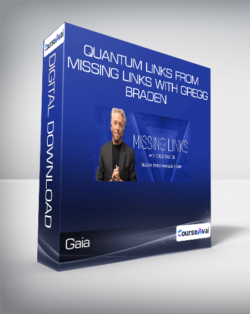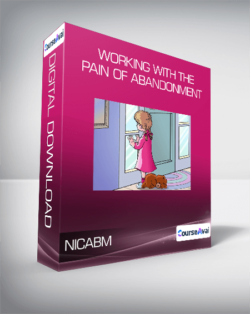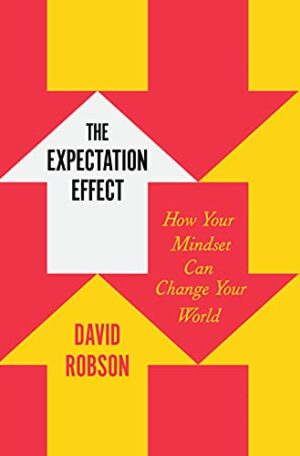Purchase NICABM – Working with the Pain of Abandonment courses at here with PRICE $97 $35NICABM – Working with the Pain of AbandonmentWorking with Abandonment: 26 Top Experts Share the Latest Strategies to Help Clients HealBeing abandoned hurts. In the moment, it can feel like you can’t breathe and that life is about to end. And then comes the painful sensations that ripple through the body and fill you with paralyzing panic.When this happens to a client, they can become fearful of ever experiencing abandonment again. Problem is, they can then develop harmful coping strategies that not only create more pain, but put them at even greater risk of being rejected.So how do we work with the desperate behavior and hair-trigger nervous system that can make abandonment a self-fulfilling prophecy?We turned to the world’s 26 top experts to hear how they work with clients who have been abandoned. Here are the latest strategies that you can start using in your work today.Working with the Pain of AbandonmentHow to Work with Clients Who Are Hypersensitive to RejectionPeter Levine, PhD Ron Siegel, PsyDJudson Brewer, MD, PhD Melanie Greenberg, PhDThe specific neural pattern that fuels a fear of abandonmentOne way to help clients shift out of a rejection-oriented mindsetHow to work with a client’s panic when being rejectedKey Strategies for Working with Abandonment and TraumaBessel van der Kolk, MD Peter Levine, PhDKelly McGonigal, PhD Resmaa Menakem, MSW, LICSW, SEPMelanie Greenberg, PhDHow PTSD can lead to powerful brain schemas that invite rejection from othersOne practice to help clients with panic disorder regulate their body when triggered by abandonmentHow trauma-informed neurofeedback can neutralize reactivity to an experience of rejectionHow to Approach Shame That Drives a Fear of RejectionDan Siegel, MDHow the ruminating brain can lock clients into ambivalent relationships that invite shameHow to work with clients whose sense of defectiveness fuels a fear of abandonmentHow to Recondition a Nervous System Damaged by AbandonmentStephen Porges, PhD Deb Dana, LCSWHow abandonment leaves a deep tracing on the nervous system (and what this means for treatment)Why the nervous system will often sabotage offers to co-regulateHow to help a client’s nervous system tolerate ruptures in a relationshipHow to Read the Abandonment Story Your Client’s Body Is TellingPat Ogden, PhD Bonnie Goldstein, PhD Deb Dana, LCSWHow to recognize possible signs of early life abandonment in your client’s bodyHow a client’s physiology can reveal the way they’re managing a fear of abandonment Ways to Change Fearful Behavior That Sets a Client Up for Further AbandonmentPat Ogden, PhD Melanie Greenberg, PhD Ron Siegel, PsyDDonald Meichenbaum, PhD Terry Real, MSW, LICSWTwo specific ways a client’s fear of abandonment can become a self-fulfilling prophecyHow to reframe a client’s neediness to make it an ally in their healingHow to help a client stay regulated when their partner rejects their needsGet NICABM – Working with the Pain of Abandonment downloadHow to Help Clients Stop Sacrificing Their Boundaries to Avoid Being AbandonedJoan Borysenko, PhD Kelly McGonigal, PhD Ron Siegel, PsyDJudson Brewer, MD, PhD Melanie Greenberg, PhD Pat Ogden, PhDThe addiction model that leads a client to soften their boundaries (and how to change it)The painful reason why some clients will gamble away their principles in a relationshipTwo practical ways to help clients shore up their personal boundariesA 3-Step Strategy to Expand a Client’s Tolerance of RejectionSteven Hayes, PhD Kelly McGonigal, PhDHow to help clients engage their fear of abandonment without getting overwhelmedHow to adjust your treatment of abandonment when the client dissociatesA compassionate strategy to help clients break a paralyzing fear of abandonmentHow to Treat A Fear of Abandonment Linked to BetrayalShelly Harrell, PhD Richard Schwartz, PhD Stan Tatkin, PsyD, MFTOne way to reduce the stigma and humiliation a client attaches to their experience of betrayalThe damaging way clients often approach decisions when they fear lossFor This Short Course on How to Work with a Client’s Pain of Abandonment, We Brought Together Some of the Top Experts in the FieldDan Siegel, MDExecutive Director of the Mindsight Institute; Co-Director of UCLA’s Mindful Awareness Research Center; author of Mindsight: The New Science of Personal Transformation and The Mindful Therapist: A Clinician’s Guide to Mindsight and Neural IntegrationBessel van der Kolk, MDNeuroscientist and Professor of Psychiatry at Boston University Medical School. Author of The Body Keeps the Score: Brain, Mind, and Body in the Healing of TraumaPeter Levine, PhDFounder of Somatic Experiencing; Author of Trauma and Memory: Brain and Body in a Search for the Living Past: A Practical Guide for Understanding and Working with Traumatic MemoryPat Ogden, PhDPioneer in Somatic Psychology; Founder and Director of Sensorimotor Psychotherapy Institute (SPI); Co-founder of the Hakomi Institute; Author of Sensorimotor Psychotherapy: Interventions for Trauma and AttachmentShelly Harrell, PhDLicensed Psychologist specializing in multicultural and community psychology; A Professor with the Pepperdine Graduate School of Education and PsychologyJoan Borysenko, PhDFounder of Mind/Body Health Sciences LLC; Author of New York Times Bestseller Minding the Body, Mending the MindStephen Porges, PhDDeveloper of Polyvagal Theory; Distinguished University Scientist at the Kinsey Institute at Indiana University Bloomington and Research Professor in the Department of Psychiatry at University of North Carolina Chapel HillSteven Hayes, PhDCreator of Acceptance and Commitment Therapy (ACT); Nevada Foundation Professor at the Department of Psychology at the University of Nevada, RenoRick Hanson, PhDSenior Fellow of the Greater Good Science Center at UC Berkeley; New York Times bestselling author of Hardwiring Happiness and Buddha’s BrainRon Siegel, PsyDAssistant Clinical Professor of Psychology, part time, Harvard Medical School; Author of The Mindfulness Solution: Everyday Practices for Everyday Problems and Sitting Together: Essential Skills for Mindfulness-Based PsychotherapyGet immediately download NICABM – Working with the Pain of AbandonmentKelly McGonigal, PhDHealth psychologist and lecturer at Stanford University; Author of The Upside of Stress: Why Stress Is Good for You and How to Get Good At It and The Willpower Instinct: How Self-Control Works, Why It Matters, and What You Can Do to Get More of ItDonald Meichenbaum PhDCreator of Cognitive Behavioral Modification (CBM); Contributor to the development of Cognitive Behavioral Therapy (CBT); author of Roadmap to Resilience: A Guide for Military Trauma Victims and Their Families.Stan Tatkin, PsyD, MFTFounder of the PACT Training Institute and developer of a Psychobiological Approach to Couple Therapy (PACT)Lynn Lyons, LICSWAuthor of Anxious Kids, Anxious Parents: 7 Ways to Stop the Worry Cycle and Raise Courageous & Independent Children, clinical social worker and psychotherapist specializing in anxiety in adults and childrenDeany Laliotis, LICSWDirector of Training at EMDR Institute; Specialist in treatment of traumatic stress disorders and attachment issues; author of chapters and articles on EMDR therapyTerry Real, MSW, LICSWFounder of the Relational Life Institute; author of I Don’t Want to Talk About It: Overcoming the Secret Legacy of Male Depression and The New Rules of Marriage: What You Need to Make Love WorkRichard Schwartz, PhDFounder of Internal Family Systems (IFS) and The Center for Self LeadershipMelanie Greenberg PhDClinical Psychologist and Author of The Stress-Proof BrainJudson Brewer MD PhDFounder of Claritas MindSciences; Formative leader in combining mindfulness and neurofeedback techniques for working with addiction; Author of The Craving MindMichael Yapko, PhDLeading expert in clinical hypnosis and treating depression; Clinical psychologist and author of 15 books including his newest books, The Discriminating Therapist and Keys to Unlocking DepressionBONNIE GOLDSTEIN PHDFounder and Director of the Lifespan Psychological Center; Co-author of Understanding, Diagnosing, and Treating AD/HD in Children and AdolescentsDeb Dana LCSWCoordinator of the Traumatic Stress Research Consortium at the Kinsey Institute; Developer of the Rhythm of Regulation Clinical Training Series; author of Polyvagal Theory in TherapyResmaa Menakem MSW LICSW SEPExpert on conflict and violence; Teacher of Cultural Somatics; Former Director of Counseling Services for the Tubman Family Alliance; Former Behavioral Health Director for African American Family Services in MinneapolisOnno van der Hart PhDPsychotraumatologist and Emeritus Professor of Psychopathology of Chronic Trauma; Co-Author of Treating Trauma-Related Dissociation and co-author of The Haunted SelfLaurel Parnell, PhDLeading expert in Eye-Movement Desensitization and Reprocessing (EMDR); Author of Attachment-Focused EMDR: Healing Relational TraumaBill O’Hanlon, LMFTCo-developer of Solution-Oriented Therapy; Psychotherapist, speaker, and author of Do One Thing Different: Ten Simple Ways to Change Your LifeHere’s What You’ll Get:Everything is yours to keep forever in your professional libraryDownloadable videos so you can watch at your convenience, on any deviceAudio recordings you can download and listen to at home, in the car, at the gym or wherever you likeProfessionally-formatted transcripts of the sessions, to make review and action simpleThree downloadable bonus videos to help you work with a Client’s Pain of AbandonmentGet 3 Bonuses That Give You Even More Strategies for Working with a Client’s Pain of AbandonmentBonus 1How to Work with Children Who Have Separation AnxietyPat Ogden, PhD Stephen Porges, PhDLynn Lyons, LICSW Bill O’Hanlon, LMFTThe parenting paradox that can often lead to insecure childrenHow to adjust external reassurances during a separation to fit the childTwo factors that have the greatest impact on a child’s ability to separate from their parentsHow to reframe a child’s fear so they can problem solve and become more flexible in lifeBonus 2How to Establish Strong Therapist-Patient Boundaries with Clients Who Have Been AbandonedDeany Laliotis, LICSW Pat Ogden, PhD Judson Brewer, MD, PhDDeb Dana, LCSW Onno van der Hart, PhD5 strategies to help clients heal from abandonment without sacrificing therapeutic boundariesHow to structure between-session contact that nourishes the client’s nervous system while honoring clinical boundariesHow the practitioner-patient therapy model could be amplifying a client’s fear of abandonment (and how to adjust it)How to foster healthy co-regulation with clients without compromising your boundariesBonus 3How to Repair Early Life Abandonment Through EMDRLaurel Parnell, PhDA two-prong approach with EMDR to help clients heal from both trauma and a negative attachment historyA powerful visualization exercise that can help clients repair painful areas of abandonment in their developmentStarting Today, This Program Can Change the Way You Practice. . . I feel so fortunate to have this access to brain power, experience and research synthesis . . .“When I listen to the experts talk openly about their experience, I feel so fortunate to have this access to brain power, experience and research synthesis on cutting edge issues! I go back to the videos to reinforce things that will assist my clients.”Mary Logan, CounselorIpswich, MAI benefit, my practice benefits, and most important my clients benefit . . .“I live in Nova Scotia and have limited travel funds at the university at which I work. The series provided by NICABM gives me the rare opportunity to listen to the leaders in the field. As a result, I learn valuable information that would not otherwise be available to me. I benefit, my practice benefits, and most important my clients benefit from the knowledge and wisdom I gain from the series.”David Mensink, PhD Counseling Psychology, PsychologistHalifax, Nova Scotia, Canada. . . some dare to go the extra journey to research and educate“These NICABM series keep me afloat, in touch, on track, well trained in my field, and more personally healthy. The best aspect, though, is that I feel validated and comforted knowing that some dare to go the extra journey to research and educate, so I can walk the path to health, and can share with others.”Mary Corsello-Vilcheck, LCSWMidlothian, VACourse DirectorRuth Buczynski, PhDDr. Ruth Buczynski is a licensed psychologist and founder and president of The National Institute for the Clinical Application of Behavioral Medicine (NICABM). NICABM helps physicians, nurses, psychologists, social workers, and counselors – practitioners who have some of the most significant and life-changing missions on the planet – provide cutting-edge, research-based treatment strategies to their patients. For more than 25 years, NICABM has offered accredited training and professional development programs to thousands of practitioners worldwide.Why the Transcript Is Essential:Click the image to enlargeImage opens in lightboxThe transcript makes it easy to go back and double check concepts, citations and names that are mentionedWe put in a table of contents to make it easy for you to find the exact part of the webinar you needHaving the concepts already written allows you to take notes on how you’re going to use the ideas rather than transcribing the ideasSome people simply learn better by reading than by listening or watchingYou will be able to print out and share techniques presented in the session with your patientsAngela Lawrence“I really liked being able to follow along with the transcripts as I listened…it was nice not to feel like I had to take notes. I really feel like I remember more when I both hear and see at the same time.”Mary Ellen McNaughton, Masters in Counseling, Psychology CounselorKelowna, British Colombia, CanadaGet NICABM – Working with the Pain of Abandonment downloadPurchase NICABM – Working with the Pain of Abandonment courses at here with PRICE $97 $35
 Ben Stewart – Limitless Season 1
₹6,142.00
Ben Stewart – Limitless Season 1
₹6,142.00
 Gaia – Quantum Links from Missing Links with Gregg Braden
₹6,142.00
Gaia – Quantum Links from Missing Links with Gregg Braden
₹6,142.00
NICABM – Working with the Pain of Abandonment
₹5,810.00





